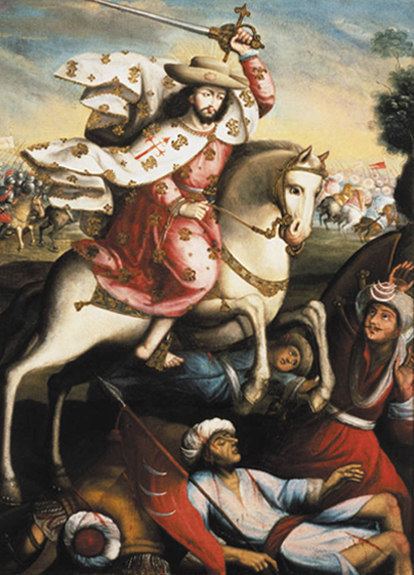 | ||
Saint James the Moor-slayer (Spanish: Santiago Matamoros) is the name given to the representation (painting, sculpture, etc.) of the apostle Saint James the Elder as a legendary, miraculous appearance at the Battle of Clavijo, fighting on the Christian side against the Muslim Moors. Historians dispute whether the battle actually happened; many of the legends were invented centuries after the supposed event. "Matamoros" is not a name nor an advocation of the saint. Aspects of the historical Battle of Monte Laturce (859) were incorporated into this legend of the battle of Clavijo, as Claudio Sánchez-Albornoz demonstrated in 1948. Historian Jean Mitchell-Lanham says "While this event is based on legend, the supposed battle has provided one of the strongest ideological icons in the Spanish national identity."
Contents
In the 17th century, followers of his cult (Santiaguistas) proposed the patronage of Spain under his name, in contrast to those who favored Saint Teresa of Avila. The Santiaguistas overcame and won this religious debate, naming him the Patron Saint of Spain until November 1760, when Pope Clement XIII rescinded this honor and officially declared the Immaculate Conception as the patroness of Spain as a country, and installed the historical Saint James the Elder the patron of Spanish people.
Origin
Christian King Alfonso II of Asturias died in 842 and was succeeded by his nephew Ramiro I.
Meanwhile, in Christian circles the legend grew that James, a disciple of Jesus, had gone to Spain, founded the Church there, and provided protection for the Christians. Historians have found no evidence for these old claims. Old bones that were discovered were venerated as his relics.
The legend was that a battle took place. On Alfonso's death, the Moors demanded the reinstation of the Tribute of 100 Virgins (fifty noble and fifty common), which Alfonso had defied. Ramiro denied them the tribute and prepared for battle. On the night before the Battle of Clavijo he dreamt of St. James, who told him that God had chosen James as the patron for the Spanish kingdoms.
According to the legend, Saint James appeared as a warrior on his white horse with a white banner to help Christian armies of king Ramiro I of Asturias in battle against the Moors. The Christians marched on the cry of "¡Dios ayuda a Santiago!" (God save St. James!). They slew more than 5,000 Moors, and James became known as "Matamoros".
Adaptation in Spanish America
Iconography of St. James was used in the Spanish colonisation of the Americas, as a rival force to the indigenous Gods and protector of Spaniards from the natives. He was depicted as a conquistador.
Namesakes
The Order of Santiago, a Spanish order of knighthood, originates from St. James' supposed involvement at the Battle of Clavijo. A wide number of Mexican settlements were named Matamoros by Spanish settlers in honour of their patron saint.
Matamoros can also be found as a Hispanic family name, for instance Miguel Matamoros.
Controversy
In the 1620s Spain debated who should be the country's patron—James, the current patron, or a combination of him and the newly canonized Saint Teresa of Ávila. Teresa's promoters said Spain faced new challenges, especially the threat of Protestantism, and the declining society at home and needed a modern patron saint who understood these problems and could lead the Spanish nation back. Santiago's supporters ("santiaguistas") fought back viciously and won the day, but Teresa of Ávila remained far more popular at the local level.
